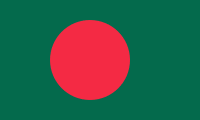
Bangladesh is a country in Asia bordered on the west, north and east by India, a small portion on the south east by Burma, and the south is the Bay of Bengal. Bangladesh has an area of 144,000 sq. km. and a population of more than 142.00 million. The country is basically a low lying land which is the delta for two major rivers in Asia (Brahmaputra and Ganges). Bangladesh boasts the largest mangrove forest in the world (part of which is in India) and the longest unbroken stretch of beach in the world ( 120 km) at Cox's Bazar.
Remnants of civilization in Bengal dates back four thousand years. In it's earlier history Bengal was ruled by various Buddhist and Hindu kingdoms. The Muslim rulers came next, and Bengal was controlled by the Delhi Sultanate. For about 200 years starting from 1339 the local governors declared their independence and were Sultans in their own right, until the Delhi Sultanate took over control again. In 1576 Bengal was absorbed into the Mughal kingdom followed by the British. The land being fertile Bengal was once the richest part of the subcontinent. Arab traders were coming to this region from the 12th century. Portuguese traders began to set up trading posts in the area of Bangladesh in the 16th century; as trading increased eventually the British East India company to control of the region and following the rebellion of 1857 it became part of British India. Most of current Bangladesh was part of old Bengal province, parts of it belonged to Assam and parts to the Arakan's. When the British left in 1947, Bengal was divided along religious lines and East Bengal joined West Pakistan. This awkward arrangement of a two-part country with its territorial units separated by 1,600 km left the Bengalis marginalized and dissatisfied. East Pakistan proclaimed independence from West Pakistan in March 1971 and was renamed Bangladesh.
The earliest known coins from this region are from the 2nd century BC. Various inscription suggests that cowrie shells was used as coinage in the medieval ages. Various 'Gold Suvarna' and 'Silver Tanka' was issued by the Hindu and Buddhist kings and Muslim Sultans. Coins under the Hindu rulers mostly had images of Goddess, while the Muslim Sultanate coins were inscribed in Arabic, some having Bengali inscription as well. Coins from local kingdoms like CoochBehar and Tripura and Bengali or similar inscriptions. When Chittagong was occupied by the Arakan kings, their coins bore Burmese, Arabic and Bengali inscriptions.
Under the Mughal rule the coinage system based on the 'Gold Mohur' and 'Silver Rupee' was introduced. Under Jahangir's rule a mint to coin gold and silver was established in Jahangirnagar. When East India Company took control of the region their coins was introduced which was followed by the coins and banknotes of British India. Their coinage was '16 Anna = 1 Rupee'. From the 1947 to 1971 coins and banknotes of Pakistan was in use. Initially they also followed the anna and rupee coinage, which was changed in 1961 to '100 paisa=1 Rupee. After independence banknotes of Pakistan was used with Bangladesh hand stamped on it. The first Bangladesh banknotes were issued in 1972 and coins in 1973. Bangladesh's currency is '1 Taka = 100 Poisha'. The Taka derived from the old Tanka coinage.
Description written by daktiket